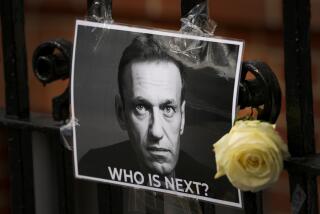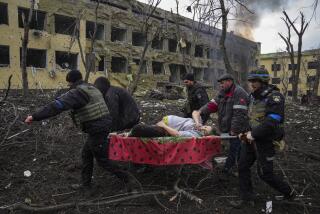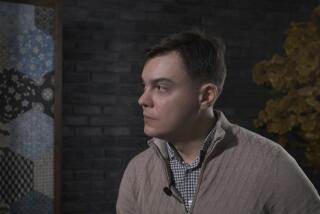Chernenko--Ailing Bureaucrat Always Considered a Transitional Leader
- Share via
MOSCOW — Konstantin U. Chernenko, the oldest man ever to assume power in the Kremlin, was plagued by health problems during his brief reign and was always regarded as a transitional leader.
Chernenko, who died Sunday, was the seventh leader of the Soviet Union and a protege of detente-minded President Leonid I. Brezhnev.
He was 72 when he came to power on Feb. 13, 1984, and he apparently ruled in collaboration with other powerful members of the Politburo. Still, he is credited with helping to revive arms talks with the United States, for it was while he was president that the Soviet Union agreed to new negotiations, scheduled to begin today, on limiting strategic and intermediate-range missiles and space weapons.
While Chernenko was president, Western diplomats assumed that Foreign Minister Andrei A. Gromyko was the dominant Kremlin figure on foreign policy issues and that military policy was shaped largely by Defense Minister Dmitri F. Ustinov before Ustinov’s death on Dec. 20, 1984.
Chernenko suffered from emphysema, which often forced him to gasp for breath and contributed to an image of weakness as a leader. His condition was complicated by liver and cardiac deficiencies. He dropped out of public view for weeks at a time, apparently because of illness, and did not appear in Red Square for Ustinov’s funeral on a day of subzero cold.
Summit Canceled
Soviet officials acknowledged that a summit meeting of Moscow’s Warsaw Pact allies, scheduled for mid-January, was canceled because Chernenko was too ill to attend.
An American diplomat described Chernenko as “a gray man of the Old Guard,” but to Soviet propagandists he displayed the “glorious traditions of the older generation.”
In some ways, he was the ultimate Communist Party bureaucrat, whose unswerving loyalty, rather than achievement, helped him up the official ladder. He had no political base of his own and never managed a ministry or a regional party organization.
His successor as the Soviet Union’s top leader is Mikhail S. Gorbachev, at 54 the youngest member of the Politburo. When they appeared together, the dynamic Gorbachev offered a sharp contrast to the white-haired, slow-moving Chernenko.
Poor Public Speaker
Chernenko’s style of public speaking was so poor that it embarrassed his colleagues. He rushed through his texts, swallowing some words and barely pronouncing others, making it difficult to understand what he was saying. On one occasion, he lost his place and skipped an entire page of his text.
On the home front, Chernenko believed in a conservative, authoritarian approach that leaned heavily on exhortation to improve worker productivity. He scorned proposals for economic reform and, as one critic said, seemed to pursue an all-stick-no-carrot policy where worker incentives were concerned.
He was a fundamentalist in artistic matters, declaring his belief in “socialist realism” to glorify the Communist Party and the working class. Soviet artists ridiculed what they called a return to the “tractors and muscle” art of the 1930s, but Chernenko’s criticism took a heavy toll on some avant-garde--at least for the Soviet Union--film and theater directors.
Chernenko was an official of the Communist Party all through his adult life, specializing in ideology. It was his connection with Brezhnev, formed when they worked together in the Soviet Moldavian Republic in the late 1940s, that allowed him to rise from obscurity in Siberia to the most powerful post in the land.
Born in Siberia
Konstantin Ustinovich Chernenko was born in the south-central Siberian village of Bolshaya Tes on Sept. 24, 1911, six years before the October Revolution that swept the Bolsheviks to power.
By Chernenko’s account, it was a hard life in a large and poor family. He left home at the age of 12 to work for a kulak, a prosperous farmer.
In typical propagandist prose, he later wrote of his childhood: “We were underfed and poorly clothed, but the dreams of a radiant (Communist) future for all fascinated us and made us feel happy.”
By the time he was 18, Chernenko was doing propaganda work in his home region, near the city of Krasnoyarsk. In 1930, he volunteered for the Red Army and was assigned to a Border Guard unit. He patrolled the frontier on horseback, and became secretary of his unit’s party cell.
Chernenko returned to full-time party work after his army service, directing agitation and propaganda in two districts near his native village. With the outbreak of World War II, millions of Soviet men went off to fight the invading Germans, but Chernenko stayed on at his civilian post in Siberia. From 1943 to 1945, he studied party organization at a special school in Moscow.
First Met Brezhnev
He then became secretary of the Penza regional party committee, a post he held for three years, until he was assigned to Moldavia to head the agitation and propaganda department. It was there that he worked with Brezhnev.
According to some reports, he was Brezhnev’s driver for a time. In any case, the two became friends and, although Chernenko took a dutiful place in the background, the friendship clearly helped his career.
In Moldavia, Chernenko went to night school to complete his education, which had been interrupted at the age of 12 when he left school to go to work. He graduated from Moldavia Teachers College in 1953, at the age of 42.
When Brezhnev was transferred to Moscow, Chernenko followed not long afterward and was assigned to a prized post in the agitation department of the party’s Central Committee in 1956.
Not until 1964, with the removal of Nikita S. Khrushchev as party leader, did the Brezhnev-Chernenko duo get a taste of real power. Brezhnev, who succeeded Khrushchev, named Chernenko secretary of the general department of the Central Committee, a key post in the powerful group.
To Politburo in 1977
With Brezhnev’s backing, Chernenko became a non-voting member of the Central Committee in 1966. Five years later, he became a full member. His rise, in the Soviet context, was rapid, for he became an alternate member of the Politburo in 1977 and was elevated to full membership the following year.
Brezhnev was clearly grooming Chernenko to be his successor. In 1975, Brezhnev sent him to the Helsinki Conference on European Security and Cooperation, and in 1979 took him along to a Vienna conference with President Jimmy Carter.
Early in 1982, Chernenko was named the third-ranking member of the Politburo. Still, when Brezhnev died, on Nov. 10, 1982, the leadership did not pass to his longtime protege.
It was Yuri V. Andropov, a former head of the security police, the KGB, who won the day. And it was Chernenko, in a move apparently designed to display Politburo unity, who nominated Andropov to be general secretary of the party. In return, Chernenko got a relatively prestigious post but was dropped from the key position of secretary of the general department.
One of Chernenko’s problems was that he never ran anything himself--never leading a district or city branch of the party--and thus had little managerial experience. Moreover, his patron, Brezhnev, was dead.
Early in 1983, Chernenko dropped out of sight. A rumor spread that he was in political disfavor. He had canceled a scheduled trip to East Berlin, and he missed the spring spectacular in Moscow, the May Day parade. His office said at first that he had a cold; later, after an absence of two months, it was reported that he had had pneumonia.
Despite rumors that he was about to be dumped from his post at the Politburo, he apparently retained Andropov’s confidence.
Then Andropov fell ill with a kidney disease. He did not appear in public after Aug. 15, 1983, and his death was announced on Feb. 9, 1984.
Compromise Candidate
Chernenko, passed over by the Politburo at its previous selection meeting, became the compromise candidate--a stunning political comeback. Still, his elevation to the leadership was announced only after a three-day interval, suggesting an internal struggle over the succession. Despite the rumors of arguments within the Politburo, it was announced that the vote for Chernenko was unanimous.
After his election early last year, the new leader embarked on five months of whirlwind activity, meeting with world leaders who were in Moscow for the Andropov funeral and later playing host to King Juan Carlos of Spain and President Francois Mitterrand of France.
Optimists took heart when Chernenko said, in March, 1984, that he favored a “drastic change in Sovet-American relations,” which were then at a low point. Reviving memories of the 1970s, when relations were better, he said, “Detente has struck deep roots.” However, pessimists said Chernenko had little leeway in altering Moscow’s foreign policy stance.
About three months before Chernenko was chosen to be leader of the Communist Party of the Soviet Union, the Soviet delegation had walked out of disarmament talks in Geneva to protest deployment of new U.S. missiles in Western Europe.
Then, for nearly a year, Soviet officials insisted that the American missiles, intended to counter Soviet SS-20 missiles aimed at Western European cities, must be removed before arms negotiations could be resumed.
New Geneva Talks
This demand was dropped, however, and on Jan. 8, 1985, Gromyko and Secretary of State George P. Shultz agreed on a framework for returning to the negotiating table.
Chernenko put less emphasis on the so-called Euromissiles issue than other members of the Kremlin hierarchy, but he joined with others in a new demand that the United States abandon research on space-based defenses against nuclear missiles.
Status of Brezhnev
On April 11, 1984, Chernenko was named president of the Supreme Soviet--the formal head of state--giving him the same status held by Brezhnev and Andropov.
In the summer of 1984, concern was again expressed about the state of Chernenko’s health; he failed to appear in public for more than seven weeks after ostensibly leaving Moscow on a vacation. But then, on Sept. 5, he reappeared, at a ceremony honoring three Soviet cosmonauts. He seemed then to be in relatively good health.
The health rumors surfaced again when Chernenko failed to appear at Ustinov’s state funeral. At the time, some Western diplomats suggested that Chernenko’s absence was only a precautionary measure due to the bitter Moscow cold.
Despite his prominence, little was known about Chernenko’s private life. Friends said he was warm-hearted and sentimental, a man who could break into tears during a sad movie or while talking about World War II.
Chernenko’s wife, Anna Dmitrievna, was little seen in public but it was noted that she wore a mink coat when she accompanied her husband to the ballot box for an election in March, 1984.
The Chernenkos had three children. A daughter, Yelena Konstantinova, works as a senior research scientist in the Marx-Lenin Institute. One son works at Goskino, the Soviet state film organization, and another son is employed in the party’s agitation-propaganda department in the provincial city of Tomsk.
More to Read
Sign up for Essential California
The most important California stories and recommendations in your inbox every morning.
You may occasionally receive promotional content from the Los Angeles Times.










